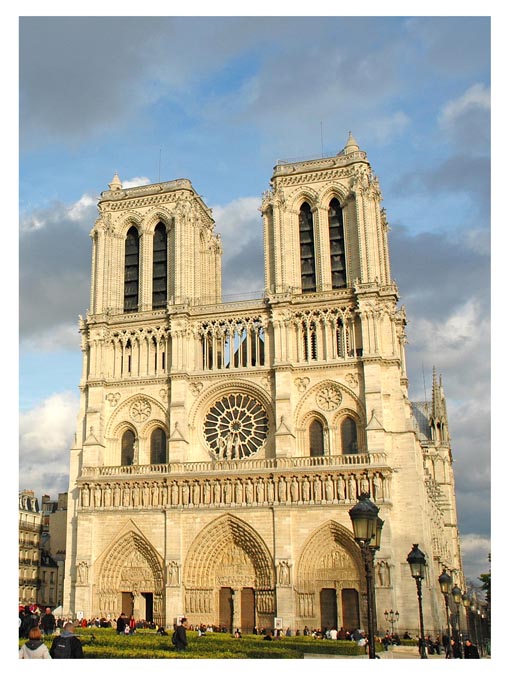
“There is nothing cleverer than irreproachable conduct.” —Queen Maria Therese in 1682
Before the arrival of Christianity in France, a Gallo-Roman temple stood on the site of Notre-Dame. The building was replaced with an Early Christian basilica dedicated to Saint Stephen. It may have been constructed in the 4th Century or the 7th Century. The Bishop of Paris, Maurice de Sully, decided to build a large church. Sully decided that the new church should be built in the Gothic style.
Our Lady of Paris, Notre-Dame, is a medieval cathedral on the Ile de la Cite in the 4th arrondissement of Paris. Construction began in 1160 and was largely complete by 1260. The cornerstone was laid in the presence of King Louis VII and Pope Alexander III.

The Cathedral is part of the UNESCO World Heritage Site. Its walls and interior vaulted ceiling are of stone. Its roof and spire were of wood made from 13th Century oak. The spire is sheathed in lead to exclude water. The spire was rebuilt several times, most recently in the 19th Century.
Since 1449 the Parisian goldsmith guild made regular donations to the cathedral chapter. In all, 76 paintings had been donated by 1708. The guild discontinued the custom for financial reasons. During the 18th Century Revolution, those works were confiscated and were dispersed among the regional museums in France.
In 1789 Notre-Dame and other clergy property in France was seized and made public property. During this time many of the treasures of the Cathedral were plundered or destroyed. The 28 statues of biblical kings at the west façade, were mistaken for statues of French kings, and were beheaded. Many of the statue heads were found during a 1977 excavation nearby and are on display at the Musee de Cluny. For a time the Goddess of Liberty replaced the Virgin Mary at several altars.
Walking amid the echoes of the footsteps of those who walked these stones in times long ago, we can hear: Josephine being crowned queen and Marie Antionette at the Te Deum giving thanks for the birth of the Dauphin; Henry IV hearing a Sunday Mass that he deemed “a kingdom was worth;” Mary Stuart and her “proud young beauty” wearing the crown of the queens of France; the mother and brothers of Jeanne d’Arc attending here to witness the ceremony in which the Church expressed deep contrition for having found the Maid of France a heretic.
In the Treasury are stored the reliquaries of the Crown of Thorns and the Nail of the True Cross along with Thomas a Becket’s cross and Napoleon’s coronation mantel. It was reported that these were saved from the fire of 2019.
To the north of the Cathedral, was the old cloister that used to be with its 51 houses for the canons. To the south are the charming gardens. Recall Hugo’s “Notre-Dame de Paris” which he wrote in 1831 when he was 29 years old and had just made a sensation in the theatre world with his “Hernani.” He was living in the rue Jean-Goujon near where the Grand-Palais is now. One day he bought himself a big bottle of ink, a supply of quills for pens and a coarse grey robe like a monk’s habit. He put his fine clothes in the closet. He had work to do and no guests were permitted.
In the next five-and-a-half months, he completed his book. He thought of calling it “What There Is in a Bottle of Ink,” but chose instead “Notre-Dame de Paris.” Hugo made 15th-Century Paris live again with all its vivid allure.
Tragedy struck April 15, 2019 when a structure fire broke out beneath the roof. The roof was destroyed and its upper walls were severely damaged. The Cathedral’s two-pipe organs and its three 13th Century rose windows suffered little to no damage.
Of the 400 firefighters engaged, three emergency workers were injured. Another 100 security personnel formed a human chain to remove precious objects to safety. The Paris Fire Brigade drilled regularly to prepare for such an emergency. One firefighter was posted to the Cathedral daily. Fire wardens checked conditions beneath the roof three times daily.
However, the Cathedral’s stonework was severely eroded by years of weather and pollution. The spire extensively had rotted because fissures in its lead sheathing were admitting water. At the time of the fire, the spire was undergoing renovation.
French president Emmanuel Macron said that the Cathedral would be restored and pledges of more than $1 Billion were raised as of April 22, 2019. Our Lady of Paris, Notre-Dame, will be again a welcoming Cathedral edifice in all her glory and honor. Viva la France.

